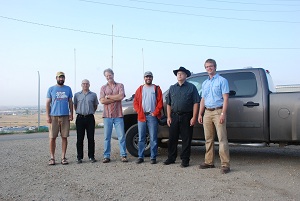UND researchers probe North Dakota oil patch man camps

An interdisciplinary team of researchers directed by William Caraher, a faculty member in the Department of History, and Bret Weber, Department of Social Work, recently conducted the first field season of the “North Dakota Man Camp Project.”
“The project aims to document the social and material conditions present in the growing number of man camps in western North Dakota’s oil patch,” said Caraher, an experienced field archeologist known for his work over several years in ancient Roman ruins in Cyprus.
The team comprises photographer John Holmgren and architectural historian Kostis Kourelis, both from Franklin and Marshall College; two archaeologists, Caraher, and Richard Rothaus, Trefoil Cultural and Environmental; and two historians, Weber, and Aaron Barth, North Dakota State University. They described a dozen camps, interviewed residents, took photographs and aerial photographs from a specially prepared kite, and prepared architectural sketches.
“The project is the first systematic archaeological and historical study of the man camps in the Bakken,” Caraher said. “It brings archaeological and historical methods to the study the ephemeral phenomenon of contemporary labor housing. By combining oral history interviews with man camp residents and archaeological documentation the team began to piece together the complex environment of settlement surrounding the Bakken oil boom.”
The man camps range from the elaborate prefabricated camps erected by and for multi-national corporations to RV parks which have become the homes to many of the Bakken patch workers.
“These RV parks include both ‘wet’ lots where units have access to water and sewage as well as dry lots which sometimes lacked even electrical hook-ups for the residents,” Caraher said. “The most elaborate camps have units with significant signs of architectural elaboration, winterized insulation, and individual decoration.”
The most rugged and informal camps featured workers housed in tents or trailers without even the most basic amenities. The residents of these camps told a wide range of stories from tales of hard luck to those of rugged individualism and fierce independence.
Overall, the North Dakota Man Camp Project has begun to document and analyze the unique environment of early 21st century temporary camps in the Bakken.
“These camps in many ways resemble the endearing character of many of North Dakota’s small towns – with their talks of triumph, individualism, community and tragedy – which became the home for the first settlers drawn to the region for the railroad and land booms of the early 20th century,” Caraher said.
For more information, contact William Caraher at 777.6379 or william.caraher@UND.edu.
— Juan Miguel Pedraza, writer/editor, University Relations, 777.6571, juan.pedraza@UND.edu
